Products are carefully selected and evaluated. If you buy through a link we may earn commission.
If you think you can skimp on running hydration, eventually it will catch up to you. It’s 100% as important to your fueling plan as gels! Today we’ll dive in to what you need to know and some options for marathon hydration vests to help you stay on track.
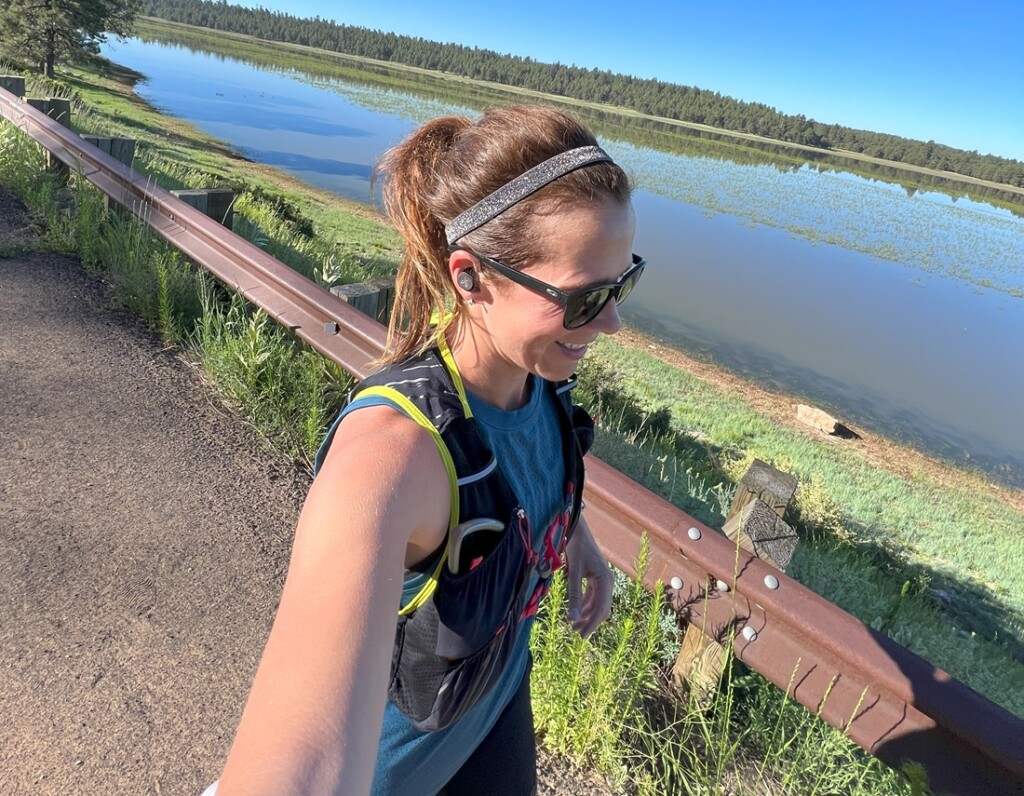
It’s no surprise that even the simplicity of water has become an area of confusion for many runners as studies change each week:
- drink before you’re thirsty…no, no this could lead to overhydration (hyponatremia),
- take in your body weight x’s 1 or 2 or 3
- drink less
- drink more
- throw your hands up and wave ‘em around…
What’s a runner to do?
Learn to trust your body and of course test all advice before race day.
On training runs for long distances, learning that you MUST carry water usually happens after a few whoops sessions like I had. You are smarter and thus ready to avoid it with the right running hydration vest or handheld.
In this article, you’ll learn everything you need to know about picking the right hydration pack, what are the best options out there, and I’ll also answer some of your most frequently asked questions about hydration packs.
👉Here is my larger detailed list of the top 10 Running Hydration Vests and Packs >>
How Much Water Should Runners Drink Daily?
Hydration isn’t just about what you do on race day! All the days in between help to improve your recovery and give you energy, so as a runner you need to drink more?
Probably.
The amount of water runners should drink daily varies depending on factors such as age, gender, body weight, activity level, climate, and overall health. However, a general guideline for daily water intake for adults, including runners, is often recommended by health authorities.
Institute of Medicine (IOM) Recommendations a total daily water intake, including all beverages and food moisture, of about 3.7 liters (125 ounces) for men and 2.7 liters (91 ounces) for women. However, it’s important to note that this includes water obtained from all sources, not just drinking water.
If you struggle to drink enough water, try adding electrolytes. That’s right, you don’t have to save them just for the run, but during the day opt for lower sodium options. The slight sweetness will help to encourage your thirst without turning to super sweetened high calorie drinks.
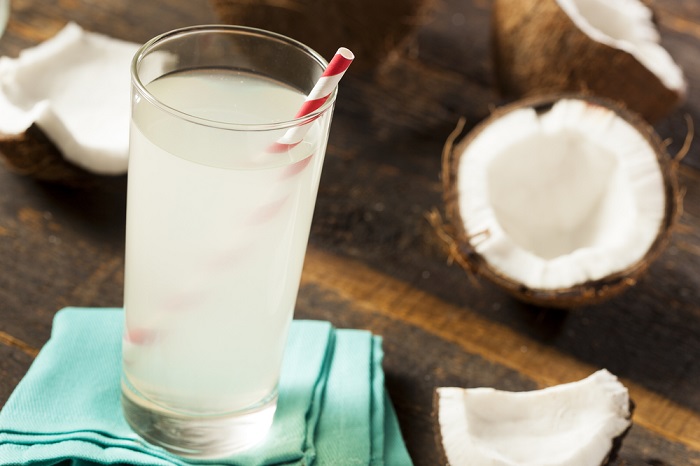
How Long of a Run Should You Bring Water?
Honestly, I like to get runners using it on every run because then it makes getting you to fuel during long runs easier. BUT I understand that’s not always doable, so if you’ll be out longer than 30 minutes bring water.
If you’re doing any kind of trail running then always bring water as there’s a chance the run will take longer than planned.
- Try sipping water at every mile this is a great habit
- Again don’t be afraid to use an electrolyte powder
- Pay attention to your thirst signals, by the time you are thirsty you are getting dehydrated
- EXCEPT for older runners, your thirst signal is lacking, so set a plan and follow it
Marathon Hydration Tips
You’ve read all about how dehydration impacts performance, so let’s instead talk about what to drink, when and the best options for carrying water on your training runs or race day.
As a long time runner, I have learned how to follow the cues of my body.
I don’t need to drink a great deal while running and when I did test out “the rules” it usually resulted in feeling bloated after running and nauseous. So not exactly conducive to a great run.
Following are what I’ve found to help me and also the runners I have coached over the years.
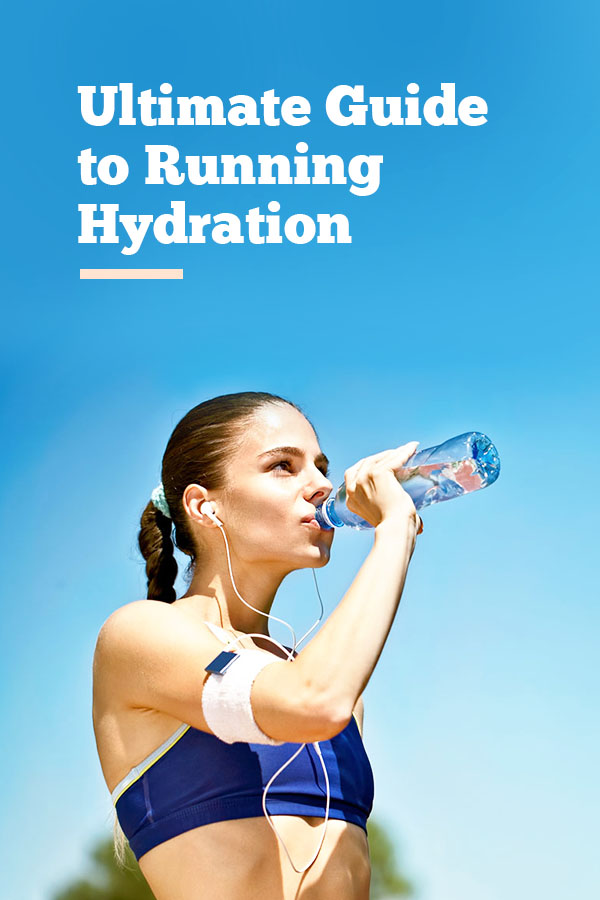
When to Drink Water While Running
One of the major complaints from runners is that feeling of slosh while running.
Some of this is due to waiting too long to drink and then guzzling, some of it is due to trying to follow running hydration guidelines that are causing us to take in more than needed.
Here are a few strategies to figure out your needs:
- Ensure 30-45 minutes pre-run you’ve had at least 8oz
- Start carrying water on every run (then you won’t forget on long runs)
- Try sipping it every mile
- Still feeling thirsty? Try sipping every couple of minutes
- Still thirsty? Check your pre-hydration again
If you don’t like the taste of flavored water, you can also take something like Salt Stick tablets before. And also during the run to help balance out sweat loss as well.
How to Drink From Cups on Race Day?
Slow down to grab the cup, squish together so you’ve created a peak on one end making it like a funnel.
Pour it in to your mouth and swish it around, rather than just gulping it! This will prevent sucking down air.
Continue with this sipping method and avoid chugging.
Some people prefer to walk through each aid station to ensure they get in water. I hate to lose momentum so I practice the sip or carrying my own water. Do what works for you.
Post-run, again it’s time to sip not guzzle which usually leads to stomach cramps while running. In fact, all the blood is currently diverted from your digestion. So you want to ease in both water and food.
For instance, one great way to do this is with a recovery smoothie which can contain a lot of hydrating foods along with water.
Is It Possible to Run a Full Marathon Without Drinking Any Water Fluids During the Run?
Yes.
Should you is a different question. But the answer I hope you know is no, it’s not ideal. In fact, you are sacrificing recovery by letting your body get into such a depleted state. And if you’re running in the heat, then you could be creating a major health issue.
So instead of trying to push yourself to some outside limit, SIP a little consistently.
What to Drink During the Marathon?
Hydration actually starts before the race.
Drink around 16-20 ounces (approximately 500-600 milliliters) of water or a sports drink about 2-3 hours before the race, and another 8-10 ounces (approximately 250-300 milliliters) about 30 minutes before the start.
During the marathon, aim to drink fluids regularly to maintain hydration. A general guideline is to consume about 4-6 ounces (approximately 120-180 milliliters) of fluid every 20 minutes. This can vary based on individual needs and the weather conditions. In hotter weather, you may need to drink more to compensate for increased sweat loss.
Do you need electrolytes, probably (depends on the distance).
If your answer is yes to any of these, adding some electrolytes to your water can help:
- Are you a heavy sweater?
- Is it a longer run than normal?
- Have you been feeling fatigued on recent runs?
- Do you have muscle cramps during or post-run?
Personally, I like to carry water on short runs and one of these great powder electrolytes or coconut water for longer runs.
The slightly sweet taste also helps your brain believe it’s getting fuel and can reduce gels needed.
 Not sure I agree, but I like the enthusiasm.
Not sure I agree, but I like the enthusiasm.
If you’re going to drink what’s on the course then know this:
- Gulping a sports drink could lead to stomach pains
- Large intake of carbohydrates like gels and sports drinks while running cause runners trots
- Try alternating grabbing the sports drink and water from aid stations
Marathon Hydration Packs
Should you race with a hydration pack? This is an extremely personal preference.
As a running coach, I tend to lean towards whatever is going to make it easiest for you to ensure that you hit both your fueling and hydration needs. It doesn’t matter how great our training cycle was if you bonk on race day because your body runs low on glycogen.
If you are very particular about what you use for fuel, are unsure of what’s offered on the course or just can’t find places to stash it all between shorts, shirts and bras…then embrace the marathon hydration vest.
In general, we are looking for options that are slim and lightweight. You don’t want to carry anything extra on race day or add unnecessary weight that could make your shoulders or back hurt.
Here are a couple of my recommendations:
Using On Course Water – UltraApsire Basham Race Vest
If you don’t need to carry a lot of liquid nutrition, you just want to be able to hold your phone, your gels and your keys then this is a absolutely winning choice.
You’ll note that you can put a bottle in the back, so you absolutely have water with you. But as long as that’s not something you will pull out frequently in the race this is a super thin and light Vest.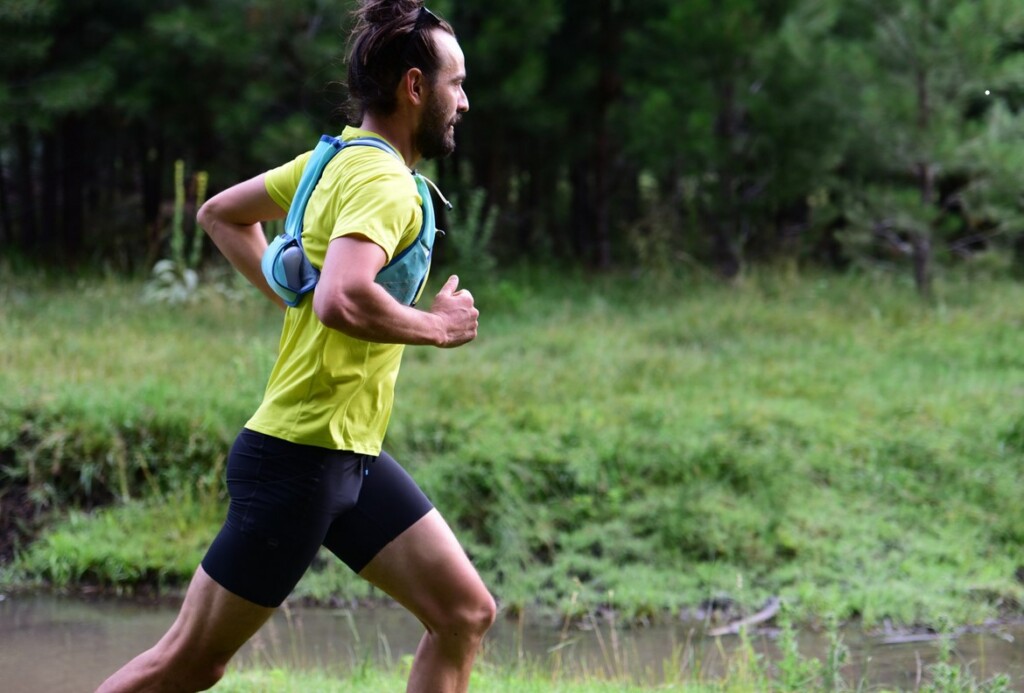
- One size fits all adjustment with toggles
- You probably won’t easily be whipping out your phone or grabbing a drink
- Super, super light
- Bottle is only .5 liters of water
- Narrow strap design to prevent strain on shoulders
Sleek and Stylish – On Running Ultra Vest ($149)
Admit it, we care about our race day photos!! I’ve heard some of you say that’s why you don’t wear a vest. So let’s find a way to stay on top of nutrition and get that great photo.
Don’t let the name fool you, this isn’t just a super long trail runners vest. Available in 5L and 10L, you can decide how much hydration you want to carry vs use on course. I personally love being able to empty out a flask and then grab water on course, my brain tells me I’m getting lighter, ha!
Bungie cord adjustment across the front and sides does make this a Unisex item, but it comes in sizes from XXS to XL.
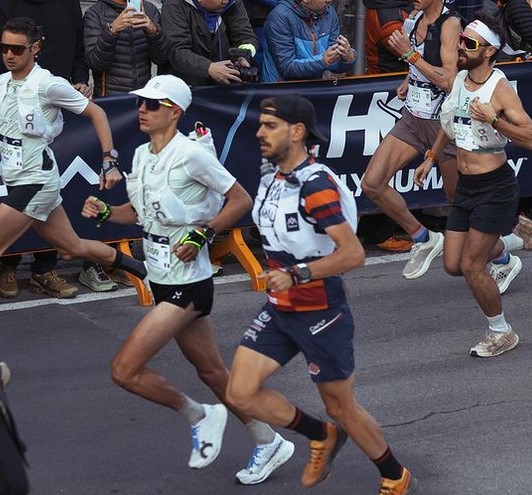
- Sleek but has deep back pockets so this works great in training too
- Available in white and black
- Stays put, no bouncing around
Easy Pockets for Phone and Fuel – Nathan Pinnacle 4L ($174)
This is what I’ve been using for a few years now in between testing other packs.
If you’ll be trying to snag photos during the race, this has a super easy zippered waterproof pocket for your phone. So you’ll avoid some of the sweat that can ruin a photo and it’s truly easy to grab on the run.
The pack’s long fit ensures an even distribution of weight centered on the back for a more comfortable run. The 12 exterior pockets, including two water-resistant zip pockets at the front, make it incredibly easy to stash away important things.
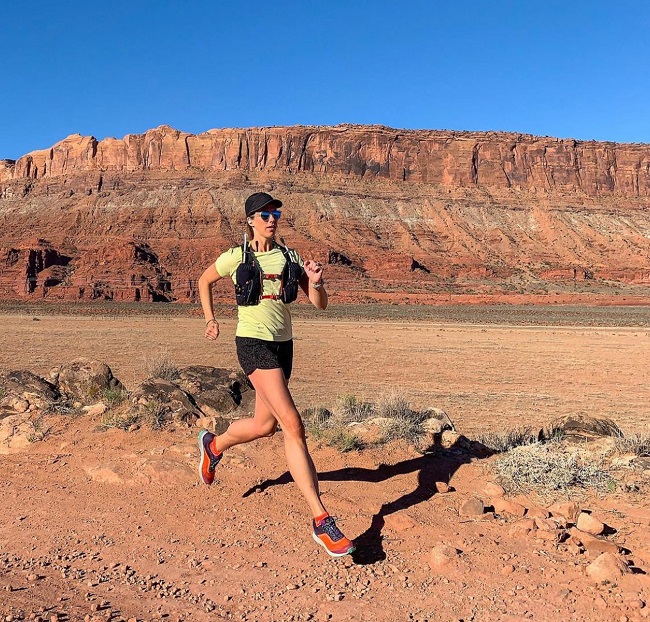
The material used is soft, stretchy, and prioritizes comfort and a bounce-free run. It’s known to slip on like T-shirt and feel comfortable even on longer runs. The tapered back also helps help encourage moisture to stay away from the skin.
The Pinnacle also comes with an insulated bladder that helps keep water cool on hot days. You can also stash away two additional 20-ounce soft flasks in the water-resistant chest straps on the front.
The vertical pocket is great for storing your trekking poles. With this pack, you’ll have plenty of space to store snacks, extra layers, etc. during a run.
Here’s why:
- I like that with two flasks I can carry water and an electrolyte
- I don’t have to clean out a bladder, but can 100% put one in for longer trail days
- It has an easy to reach phone pocket upfront
- Plenty of packs in the back for when I overdress or want to carry trekking poles
- It’s slim and works as a race vest
- Straws can be trimmed so they aren’t so long
I used this for our entire Moab trail adventure vacation and that sealed the deal, I’ll continue to use it. I also went with a small women’s size, which felt like a secure fit that doesn’t bounce around.
Bustier ladies, I don’t know that the straps on this would work well.
Opt for a Belt Instead – Nathan Peak Hydration Belt ($40)
If you’re looking for a running belt that’ll stay in place and won’t distract you during your next race, then this is the one for you. Ideal for racers who worry about getting too hot from a hydration vest on their back or across the chest. Just makes sure you’ve tested it to find the right fit.
This Nathan Sports Peak running belt comes with a large 18 oz flask with a push and pull race cap that makes it easy to use during a run. The angled bottle holder also allows for an easy one-handed access that’s super convenient.
Coach Stacey from our team wore this in Chicago and thought it was a great fit. It’s adjustable and can fit waist sizes of 26 to 44 inches.
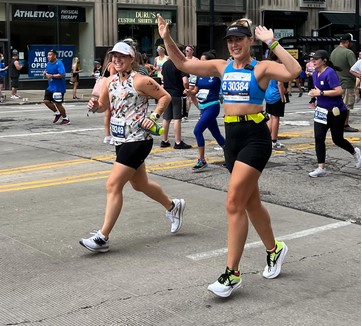
- Carries 18 oz (flask included)
- Easy to quickly grab water and replace it while running
- Compartments on side for quick access to your fuel
- May not be super comfortable with a large phone since the pocket is on your side where it curves
- Most runners have said it’s truly bounce free with the velcro closure
There are some cheaper packs that only hold a bladder for water and I have not recommended these largely because they don’t provide any EASY place to store or access your gels during the race.
Do Marathon Runners Wear Hydration Packs?
Sometimes. As much as I love having my hydration pack in training, I actually love to shed it on race day and feel lighter.
What I will then do is carry a bottle with my electrolytes for the first half. In fact, I have some leggings with pockets where I can shove that bottle. Then toss it at an aid station and switch to water.
There is NO REAL RUNNER RULE prohibiting you from wearing one. So if it’s a hot race, if you have a super sensitive stomach and know what works for you, then wear it!
***NOTE sometimes there are rules! Like the Chicago Marathon or other large marathons that prohibit them for safety reasons.
Other ways to connect with Amanda
Instagram Daily Fun: RunToTheFinish
Facebook Community Chatter: RunToTheFinish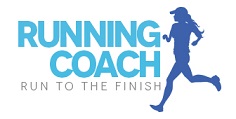
Sign Up to Receive a Weekly Newsletter with Top Running Tips and Laughs

